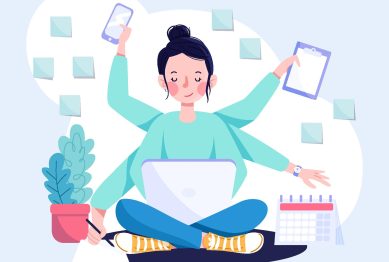Have you ever looked back and thought, “If I knew then what I know now”? What if you could reverse that—what if you now could learn from the person you once were? More people are discovering that one of the most powerful personal development tools is to use past versions of yourself as teachers. From career growth to emotional resilience, your past experiences can be the roadmap for smarter, more confident decisions today.
This emerging trend in self-improvement—called self-coaching—shifts the focus from external advice to internal reflection. By examining your past actions, beliefs, and challenges, you gain valuable insights that fuel future progress.

Why Look Back? The Science of Self-Reflection
Reflecting on past experiences is more than just nostalgia—it’s a proven method for enhancing emotional intelligence, decision-making, and focus. Psychologists call this process autobiographical reflection, and it’s a key function of the brain’s default mode network—the part that activates when you’re introspective.
A study published in Nature Reviews Neuroscience found that people who regularly reflect on their personal history are better equipped to regulate emotions, set goals, and learn from mistakes. In other words, you can train your brain to grow by looking backward.
Another study from Harvard Business School concluded that individuals who spent just 15 minutes reflecting at the end of their workday performed 23% better than those who didn’t. The takeaway? Using past versions of yourself can enhance present performance and future outcomes.
Hot Trend: Self-Coaching Through Digital Reflection Tools
The trend of self-coaching—using structured self-reflection rather than traditional coaching—has exploded with the rise of digital memory tools like Notion, Obsidian, and Reflect. These platforms help users log thoughts, track goals, and analyze their growth over time.
What’s driving this shift? People are recognizing that they are their own best teachers. By using tools to revisit journal entries, goal progress, and decision logs, users are crafting a personal feedback loop—learning from “past me” to improve “present me.”
How to Use Past Versions of Yourself: A Step-by-Step Guide
Here’s how to transform your past into your personal coach:
1. Create a Reflection Habit
Set aside weekly reflection time. Use prompts like:
- “What did I learn this week?”
- “What would I tell my past self about this situation?”
- “How would my past self handle this differently?”
Document your responses in a dedicated journal or app to build a timeline of insights.
2. Review Old Journals, Notes, and Messages
Your past thoughts are a goldmine. Look at:
- Journals or diaries
- Emails or messages during stressful times
- Old to-do lists or goal sheets
Ask: What patterns emerge? What advice would my past self offer now?
3. Conduct a “Past Self Audit”
Choose a specific version of yourself from 1, 3, or 5 years ago and evaluate:
- What beliefs did I hold then?
- What goals did I have?
- What decisions worked out—or didn’t?
This audit reveals how your mindset has evolved and what lessons are still relevant.
4. Record “Lessons Learned” Playlists
Just like musicians record demo tracks, record voice memos or write entries cataloging:
- Wins and what contributed to them
- Failures and what caused them
- Personal rules or mantras that worked
This creates a library of “teachings” from your past self for future use.
5. Use Time-Stamped Goals
When setting new goals, reference past goals for context:
- “What would 2020-me think of this goal?”
- “Am I repeating a past mistake or learning from it?”
This keeps your growth trajectory visible and grounded.
Using Past Versions for Emotional Resilience
Self-reflection is also a powerful tool for managing stress and building resilience. When life gets overwhelming, revisit times when you faced similar challenges.
Ask:
- “How did I overcome that difficulty?”
- “What strengths did I use?”
- “What advice would I give myself now?”
According to Neff (2011), reflecting on past challenges and responding with self-compassion improves emotional well-being and boosts your ability to handle stress.more, reducing overthinking and boosting confidence.
Trend Highlight: Digital Memory Tools for Self-Coaching
Apps like Evernote, Obsidian, and Notion now support linked notes and timelines—allowing users to map their thought processes over time. These tools help track:
- Emotional states
- Decision outcomes
- Goal progress
By connecting these dots, you create a feedback loop where past you coaches current you—a dynamic that’s becoming a cornerstone of digital mindfulness.
Use Past Versions of Yourself to Cultivate Resilience
Resilience isn’t just bouncing back—it’s learning forward. Reviewing past challenges and how you handled them builds a toolkit for future stressors.
Try these prompts:
- “How did I get through my last tough period?”
- “What strengths did I rely on then?”
- “What advice would past-me give me today?”
This process activates positive self-dialogue, helping to reduce anxiety and boost coping strategies.
When the Past Should Stay in the Past
Not every past experience is helpful. Be cautious of:
- Ruminating over mistakes without learning from them
- Holding onto outdated beliefs that limit growth
- Over-idealizing past success, leading to stagnation
The goal is to extract lessons, not live in the past. Reflection should empower, not trap you.
Why This Approach Matters Now
In today’s fast-paced world, we’re inundated with external opinions, productivity advice. But real growth often comes from internal clarity—understanding your own journey, choices, and lessons.
By learning to use past versions of yourself, you reclaim that clarity. You stop second-guessing and start making focused, informed decisions that align with your true values and goals.
Conclusion
In a world overflowing with external advice, turning inward may be your smartest move. Learning to use past versions of yourself as teachers creates a personalized guide for growth—one rooted in real experience, not generic tips.
By reviewing your own journey, you gain insight, clarity, and direction. Your past isn’t just history—it’s a resource. Tap into it wisely, and you’ll always have a mentor who truly understands where you’ve been—and where you want to go.
Reference
- King, L. A. (2001). The health benefits of writing about life goals. Personality and Social Psychology Bulletin, 27(7), 798–807. https://doi.org
- Neff, K. D. (2011). Self-compassion, self-esteem, and well-being. Social and Personality Psychology Compass, 5(1), 1–12. https://doi.org
- Smallwood, J., & Schooler, J. W. (2015). The science of mind wandering: Empirically navigating the stream of consciousness. Nature Reviews Neuroscience, 16(11), 718–731. https://doi.org









